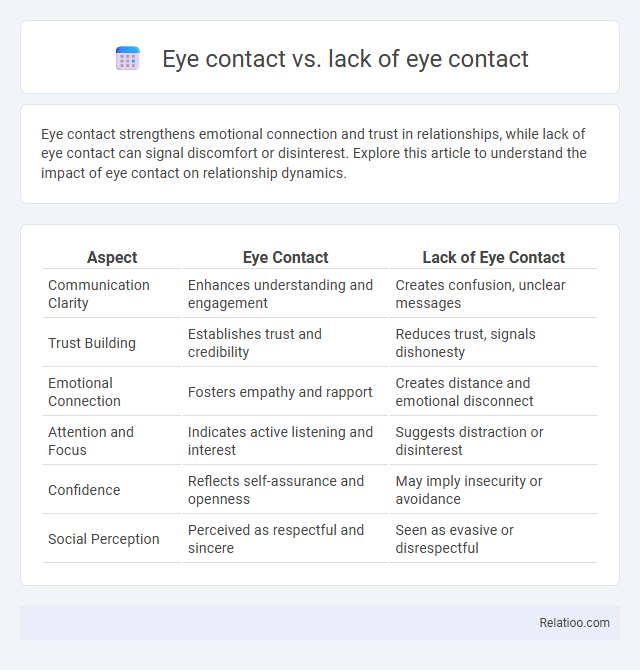Eye contact strengthens emotional connection and trust in relationships, while lack of eye contact can signal discomfort or disinterest. Explore this article to understand the impact of eye contact on relationship dynamics.
Table of Comparison
| Aspect | Eye Contact | Lack of Eye Contact |
|---|---|---|
| Communication Clarity | Enhances understanding and engagement | Creates confusion, unclear messages |
| Trust Building | Establishes trust and credibility | Reduces trust, signals dishonesty |
| Emotional Connection | Fosters empathy and rapport | Creates distance and emotional disconnect |
| Attention and Focus | Indicates active listening and interest | Suggests distraction or disinterest |
| Confidence | Reflects self-assurance and openness | May imply insecurity or avoidance |
| Social Perception | Perceived as respectful and sincere | Seen as evasive or disrespectful |
Introduction to Eye Contact in Communication
Eye contact serves as a vital nonverbal cue that conveys attention, confidence, and sincerity in communication, directly impacting how messages are received and interpreted. Lack of eye contact often signals discomfort, disinterest, or evasiveness, potentially leading to misunderstandings and weakened interpersonal connections. Your ability to maintain appropriate eye contact enhances trust and engagement, making it a fundamental element in effective communication.
The Psychology Behind Eye Contact
Eye contact functions as a powerful nonverbal cue that influences social interaction, conveying attention, confidence, and emotional connection. Lack of eye contact can signal discomfort, disinterest, or deception, often impacting interpersonal trust and communication effectiveness. Psychological studies reveal that maintaining appropriate eye contact activates brain regions linked to social cognition, highlighting its role in empathy and understanding others' intentions.
Cultural Differences in Eye Contact Norms
Eye contact serves as a powerful nonverbal cue, signaling confidence, attentiveness, or respect, yet cultural differences can dramatically alter its interpretation; in some cultures, direct eye contact signifies honesty and engagement, while in others it may be viewed as disrespectful or confrontational. Lack of eye contact may be perceived as shyness, disinterest, or even deceit in Western contexts, whereas in many Asian or Indigenous cultures, avoiding direct gaze serves as a sign of politeness or deference. Your awareness of these cultural nuances can enhance interpersonal communication and prevent misunderstandings in diverse social and professional settings.
Positive Effects of Making Eye Contact
Making eye contact fosters trust, enhances communication, and strengthens interpersonal connections by signaling attentiveness and confidence. Positive effects include improved emotional understanding, increased rapport, and greater engagement in social and professional interactions. In contrast, lack of eye contact can convey disinterest or insecurity, while effective nonverbal cues, such as consistent eye contact, reinforce verbal communication and promote mutual respect.
Negative Consequences of Avoiding Eye Contact
Avoiding eye contact often signals disinterest, dishonesty, or insecurity, which can damage trust and hinder effective communication in personal and professional settings. Lack of eye contact may lead to misunderstandings and reduced rapport, negatively impacting relationship building and collaboration. Nonverbal cues like averted gaze can be misinterpreted as evasiveness, causing social discomfort and decreasing conversational engagement.
Eye Contact and Building Trust
Eye contact plays a crucial role in building trust by signaling attention, confidence, and honesty during interpersonal communication. A lack of eye contact often creates perceptions of disinterest, evasiveness, or insecurity, which can hinder relationship development. Nonverbal cues, including consistent eye contact, enhance trustworthiness and facilitate deeper emotional connections in both personal and professional interactions.
Lack of Eye Contact: Social and Emotional Signals
Lack of eye contact often signals discomfort, nervousness, or evasiveness in social interactions and can indicate underlying emotional distress or insecurity. It serves as a nonverbal cue that may reflect disinterest, avoidance, or a desire to withhold information, impacting communication effectiveness. Understanding the social and emotional signals of absent eye contact improves interpretation of interpersonal dynamics and emotional states.
Eye Contact in Professional Settings
Eye contact in professional settings serves as a powerful nonverbal cue that conveys confidence, attentiveness, and credibility, enhancing communication effectiveness. Lack of eye contact often signals disinterest, insecurity, or evasiveness, which can undermine trust and reduce the impact of the message. Maintaining consistent and appropriate eye contact fosters engagement, builds rapport, and supports positive interpersonal interactions in the workplace.
Eye Contact Challenges: Anxiety and Neurodiversity
Eye contact challenges often arise in individuals with anxiety and neurodiverse conditions, where sustained gaze can trigger discomfort or sensory overload. Lack of eye contact serves as a critical nonverbal cue that may indicate emotional distress, social anxiety, or conditions such as autism spectrum disorder. Understanding these variations in eye contact helps improve communication strategies and fosters inclusive social interactions.
Strategies for Improving Eye Contact Skills
Improving eye contact skills involves understanding its role as a powerful nonverbal cue that conveys confidence and attentiveness, while lack of eye contact may signal discomfort or disinterest. You can practice by maintaining natural eye engagement during conversations, gradually increasing duration without staring to enhance connection and trust. Techniques such as focusing on the area between the eyebrows and practicing in front of a mirror or with a friend effectively boost your ability to establish positive visual communication.

Infographic: Eye contact vs Lack of eye contact
 relatioo.com
relatioo.com